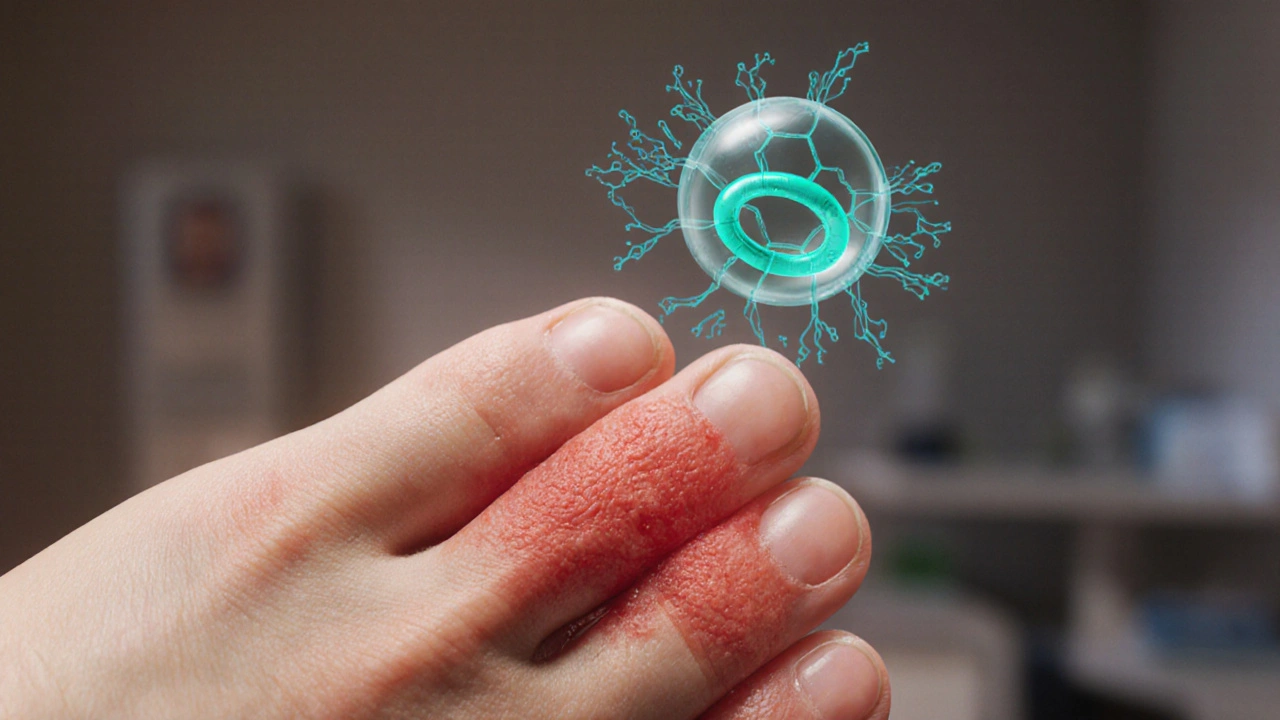
Colchicine vs Alternatives Decision Tool
Recommended Treatment
Treatment Comparison
| Treatment | Speed of Relief | Side Effect Risk | Cost | Best For |
|---|
When a gout flare hits, patients often wonder if colchicine is the only option or if other drugs might work better. This guide breaks down colchicine and its most common alternatives, comparing how they act, how quickly they kick in, typical side effects, and practical considerations like cost and contraindications.
Key Takeaways
- Colchicine works by stopping inflammation at the cellular level, making it fast‑acting but prone to gastrointestinal upset.
- NSAIDs (e.g., indomethacin, naproxen) provide strong pain relief but can stress the stomach and kidneys.
- Corticosteroids (e.g., prednisone) are useful when NSAIDs and colchicine are contraindicated, yet they carry long‑term metabolic risks.
- Biologic IL‑1 blockers (e.g., canakinumab, anakinra) target the root inflammatory pathway and are reserved for refractory gout.
- Urate‑lowering drugs (allopurinol, febuxostat) don’t treat acute attacks but prevent future flares.
What Is Colchicine?
Colchicine is a plant‑derived alkaloid that inhibits microtubule polymerization, reducing the migration of neutrophils to inflamed joints. First approved for gout in the 1970s, colchicine remains a cornerstone for acute attacks because it starts working within 12-24hours. Typical dosing is 1.2mg followed by 0.6mg one hour later, then 0.6mg every 8hours if needed, adjusted for kidney function.

Common Alternatives and How They Differ
Below are the most frequently prescribed alternatives, each with its own mechanism, dosing, and pros/cons.
Indomethacin is a non‑steroidal anti‑inflammatory drug (NSAID) that blocks cyclooxygenase enzymes, decreasing prostaglandin production. It’s often given as 50mg three times daily for the first 48hours, then tapered.
Naproxen is another NSAID, preferred for patients who need a longer‑acting option; dosing is 500mg twice daily.
Prednisone is a corticosteroid that suppresses the entire immune response, rapidly reducing inflammation. Typical regimen starts at 30mg daily, tapering over 7‑10days.
Canakinumab is a monoclonal antibody targeting interleukin‑1β, directly neutralizing a key driver of gout inflammation. It’s administered as a single 150mg sub‑cutaneous injection for refractory attacks.
Anakinra blocks the interleukin‑1 receptor, offering rapid relief within 24hours; dosing is 100mg daily for up to 5days.
Allopurinol is a xanthine oxidase inhibitor that reduces uric acid production, used for long‑term flare prevention rather than acute relief. Starting dose is 100mg daily, titrated up to 300mg.
Febuxostat is another xanthine oxidase inhibitor, often chosen for patients intolerant to allopurinol. Standard dose begins at 40mg daily, increasing to 80mg.
Side‑Effect Profiles at a Glance
| Drug | Common Side Effects | Serious Risks | Special Precautions |
|---|---|---|---|
| Colchicine | Diarrhea, nausea, abdominal cramping | Myopathy, bone‑marrow suppression (rare) | Avoid high doses in renal/hepatic impairment |
| Indomethacin | Stomach upset, headache | GI bleeding, renal failure, cardiovascular events | Use with proton‑pump inhibitor if chronic |
| Naproxen | Heartburn, dizziness | GI ulceration, increased CV risk | Prefer low‑dose for elderly |
| Prednisone | Weight gain, mood swings | Hyperglycemia, osteoporosis, adrenal suppression | Short courses only; taper off gradually |
| Canakinumab | Injection site pain, mild infection | Serious infection, neutropenia | Screen for TB before use |
| Anakinra | Injection site reactions, mild fever | Severe infection risk | Avoid in active infections |
| Allopurinol | Rash, mild GI upset | Allopurinol hypersensitivity syndrome | Start low, monitor renal function |
| Febuxostat | Elevated liver enzymes, rash | Increased cardiovascular mortality (caution) | Assess CV risk before prescribing |

Cost and Accessibility
Price often decides which drug patients actually take. Generic colchicine costs roughly $0.15 per tablet in the U.S., making it one of the most affordable gout options. Indomethacin and naproxen are similarly cheap, usually under $0.10 per dose. Prednisone is inexpensive but may require monitoring for long‑term side effects.
Biologics like canakinumab and anakinra can exceed $2,000 per injection, limiting their use to specialty clinics and insurance‑covered cases. Allopurinol and febuxostat are moderate‑priced chronic therapies, with febuxostat being about 2‑3× more expensive than allopurinol.
Choosing the Right Option for You
Here’s a quick decision flow you can run with your doctor:
- If you need **rapid relief** and have normal kidney function, start with colchicine or an NSAID.
- If you have **renal insufficiency** or an ulcer history, skip NSAIDs and consider low‑dose colchicine or a short prednisone taper.
- If you’ve tried both **colchicine and NSAIDs** without success, discuss IL‑1 blockers (canakinumab or anakinra) for refractory gout.
- Regardless of the acute treatment, evaluate whether you need a **urate‑lowering drug** (allopurinol or febuxostat) to prevent future attacks.
Always factor in drug interactions. For example, colchicine should not be combined with strong CYP3A4 inhibitors like clarithromycin, as it can raise colchicine levels to toxic ranges.
Frequently Asked Questions
Can I take colchicine and ibuprofen together?
Combining colchicine with ibuprofen is generally safe, but both drugs can affect the stomach. Use the lowest effective doses and consider a proton‑pump inhibitor if you have a history of ulcers.
Why does colchicine cause diarrhea?
Colchicine interferes with the microtubules in intestinal epithelial cells, speeding up cell turnover and leading to loose stools. Hydration and dose adjustment usually help.
Are NSAIDs better than colchicine for gout?
NSAIDs often provide stronger pain relief, but they carry higher risks for the stomach, kidneys, and heart. Colchicine works faster on the inflammation cascade and is cheaper, making it a good first‑line choice for many patients.
When should I consider a biologic like canakinumab?
Biologics are reserved for patients who have frequent flares despite optimal colchicine, NSAID, and corticosteroid therapy, or who cannot tolerate those drugs due to side effects or comorbidities.
Do I need a urate‑lowering drug if I take colchicine for attacks?
Colchicine treats only the acute inflammation. To keep uric acid levels low and prevent future attacks, a long‑term urate‑lowering medication like allopurinol or febuxostat is usually recommended.


When you look at the landscape of gout management, colchicine stands out not just because of its speed but also because of its unique mechanism that targets microtubules. It works by halting neutrophil migration, which is the root of the painful inflammation. This early interruption translates into relief within 12‑24 hours for most patients. The drug’s low cost makes it especially attractive in resource‑limited settings, something many clinicians overlook. However, the narrow therapeutic window means dosing has to be adjusted for renal and hepatic function, otherwise toxicity can creep in. Gastrointestinal upset, especially diarrhea, is the most common side effect and can be mitigated by splitting the dose. In practice I often start with 1.2 mg then follow with 0.6 mg after an hour, watching the patient closely for any stomach discomfort. For patients with normal kidney function, this regimen is usually well tolerated and avoids the need for high‑dose NSAIDs. Speaking of NSAIDs, while they provide rapid pain control, they carry a higher risk of gastric bleeding and renal impairment, which can be a deal‑breaker for many older adults. Corticosteroids are an alternative when both colchicine and NSAIDs are contraindicated, but long‑term steroid use brings its own baggage of metabolic side effects. Biologic agents like canakinumab or anakinra are reserved for refractory gout, largely because of their astronomical price tags and infection risk. Allopurinol and febuxostat, on the other hand, are not acute agents but essential for lowering urate chronically, preventing future flares. The decision tree really hinges on the patient’s comorbidities, cost considerations, and how quickly they need pain relief. In my clinic, I use a simple questionnaire to decide whether to start colchicine, an NSAID, or jump straight to a short steroid taper. Education about drug interactions is crucial; for example, combining colchicine with strong CYP3A4 inhibitors can push levels into dangerous territory. Monitoring renal function before and during therapy helps avoid accumulation. Finally, patient adherence improves when the regimen is cheap, simple, and explained in plain language, which is why colchicine remains a cornerstone for many providers. Overall, the balance of efficacy, speed, and affordability makes colchicine a first‑line choice for most acute gout attacks.
From a pharmaco‑kinetic perspective, colchicine’s bioavailability (~45%) and hepatic metabolism via CYP3A4 allow for rapid attainment of therapeutic plasma concentrations, which is why we see that 12‑24 hour window of relief!!! In contrast, NSAIDs like indomethacin boast a faster onset (2‑4 hrs) but suffer from COX‑1 inhibition‑related GI toxicity, especially in patients with a history of ulcers. The trade‑off between speed and safety is why I often advocate for a “risk‑stratified algorithm” in clinical pathways; you weigh renal function, cardiovascular comorbidities, and concomitant meds before selecting an agent. For patients on clarithromycin or itraconazole, a dose reduction of colchicine by 50% is mandatory to prevent myopathy. Moreover, the economic impact cannot be ignored-colchicine at $0.15/tab is a bargain compared to biologics that exceed $2,000 per injection! When counseling patients, I emphasize the importance of hydration and dietary purine restriction alongside pharmacotherapy, thereby reducing flare frequency. Clinical guidelines now suggest using low‑dose colchicine (0.6 mg once daily) as prophylaxis when initiating urate‑lowering therapy, which also shortens the latency to achieve target serum urate levels. In practice, I’ve observed that patients who understand these nuances adhere better to the regimen, leading to fewer emergency department visits. So, while colchicine isn’t a panacea, its pharmacologic profile makes it a versatile tool in the gout armamentarium.
Great rundown! 👍 Colchicine really is a budget‑friendly hero for most gout attacks, but you’ve got to watch the stomach-diarrhea can knock you out. If you pair it with a mild probiotic, it sometimes eases the GI upset. Also, remember to avoid grapefruit juice; it can raise colchicine levels. 💊 Keep an eye on kidney labs, especially if you’re older. 😊
👍 Absolutely, the balance between speed and safety is key. I’ve seen patients who were terrified of NSAIDs because of past ulcers, and a low‑dose colchicine regimen gave them quick relief without the GI drama. It’s also nice when the cost doesn’t force them to skip medication. In short, personalizing the approach based on comorbidities makes a huge difference in outcomes.
To add a mechanistic layer, colchicine binds to tubulin heterodimers, preventing polymerization, which in turn disrupts the assembly of the inflammasome complex-this is why it curtails IL‑1β release much faster than NSAIDs, which merely block prostaglandin synthesis. Moreover, the drug’s narrow therapeutic index stems from its renal excretion; accumulation can precipitate neuromuscular toxicity, especially in the elderly. Clinical trials have shown that a 0.6 mg dose every 12 hours is non‑inferior to the traditional 1.2 mg loading then 0.6 mg maintenance schedule, with fewer GI events. In terms of drug‑drug interactions, strong P‑gp inhibitors (e.g., cyclosporine) can double colchicine plasma concentrations, so dose adjustments are mandatory. Lastly, the cost‑effectiveness analyses consistently rank colchicine as the most favorable option when you factor in hospitalization avoidance for severe flares.
It’s uplifting to see how many effective options we have now. Even though colchicine is cheap, the newer biologics open doors for patients who have exhausted traditional therapies. When we combine empathy with evidence‑based choices, patients feel empowered rather than scared of their disease.
Indeed, the philosophical underpinning of personalized medicine is that each patient’s narrative shapes the therapeutic pathway. While the science guides us, we must also listen to the lived experience of pain, fear, and hope. A brief conversation about lifestyle, diet, and support systems can be as therapeutic as any drug.
Colchicine works fast.
Love how the guide breaks down each drug’s pros and cons-makes it easier to have an informed discussion with the doctor. Even the cost section is super helpful; I never realized how expensive the biologics can get.
The overview is clear and concise, good job presenting the info without overloading the reader.
Honestly, the article feels a bit like a sales pitch for colchicine. It downplays the seriousness of GI side effects and jumps to cost comparisons without enough nuance.
Colchicine is a tried‑and‑true American drug; we should trust the home‑grown options over foreign biologics that cost a fortune.
Dear readers, it is with great pleasure that I present a concise, yet comprehensive synthesis of the current therapeutic armamentarium for acute gouty arthritis. The foregoing discourse delineates the pharmacodynamic virtues of colchicine, juxtaposed with the rapid analgesic potency of NSAIDs, the systemic immunosuppression afforded by corticosteroids, and the contemporary advent of IL‑1 blockade via canakinumab and anakinra. Each modality’s risk–benefit profile has been meticulously examined, offering clinicians a robust framework for individualized patient care. I trust this exposition will prove indispensable in guiding judicious therapeutic selections.
Sounds fancy, but at the end of the day, most of us just need something that stops the pain fast. Fancy biologics are for the rich.
While the clinical data are solid, let’s not forget that language matters-terms like “refractory” can sound intimidating. A colorful metaphor, say, “when gout storms strike, we need the right arsenal to weather the tempest,” might engage patients more effectively.
I appreciate the cultural sensitivity of the guide; it mentions diet variations across regions, which is vital for global patients coping with gout.
Yo! This guide is lit-especially the part about not mixing colchicine with strong antibiotics. Gotta keep it real and stay safe, fam! 💥
In summary, the optimal gout strategy is a symphony of rapid‑acting agents for flares, long‑term urate‑lowering therapy, and vigilant monitoring for adverse events. By harmonizing cost, efficacy, and patient preference, clinicians can orchestrate lasting relief.